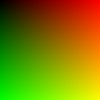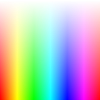 |
 |
 |
 |
| Name |
|
colorMode() |
 |
|
|
| Examples |
|
 |
noStroke();
colorMode(RGB, 100);
for(int i=0; i<100; i++) {
for(int j=0; j<100; j++) {
stroke(i, j, 0);
point(i, j);
}
}
|
 |
 |
noStroke();
colorMode(HSB, 100);
for(int i=0; i<100; i++) {
for(int j=0; j<100; j++) {
stroke(i, j, 100);
point(i, j);
}
}
|
 |
|
| Description |
|
Changes the way Processing interprets color data. By default, fill(), stroke(), and background() colors are set by values between 0 and 255 using the RGB color model. It is possible to change the numerical range used for specifying colors and to switch color systems. For example, calling colorMode(RGB, 1.0) will specify that values are specified between 0 and 1. The limits for defining colors are altered by setting the parameters range1, range2, and range 3. |
 |
|
|
| Syntax |
|
colorMode(mode);
colorMode(mode, range);
colorMode(mode, range1, range2, range3);
|
 |
|
|
| Parameters |
|
| mode |
|
Either RGB or HSB, corresponding to Red/Green/Blue and Hue/Saturation/Brightness
|
| range |
|
int or float: range for all color elements
|
| range1 |
|
int or float: range for the red or hue depending on the current color mode
|
| range2 |
|
int or float: range for the green or saturation depending on the current color mode
|
| range3 |
|
int or float: range for the blue or brightness depending on the current color mode
|
|
 |
|
|
| Returns |
|
None |
 |
|
|
| Usage |
|
Web & Application |
 |
|
|
| Related |
|
background()
fill()
stroke()
|
|
|


